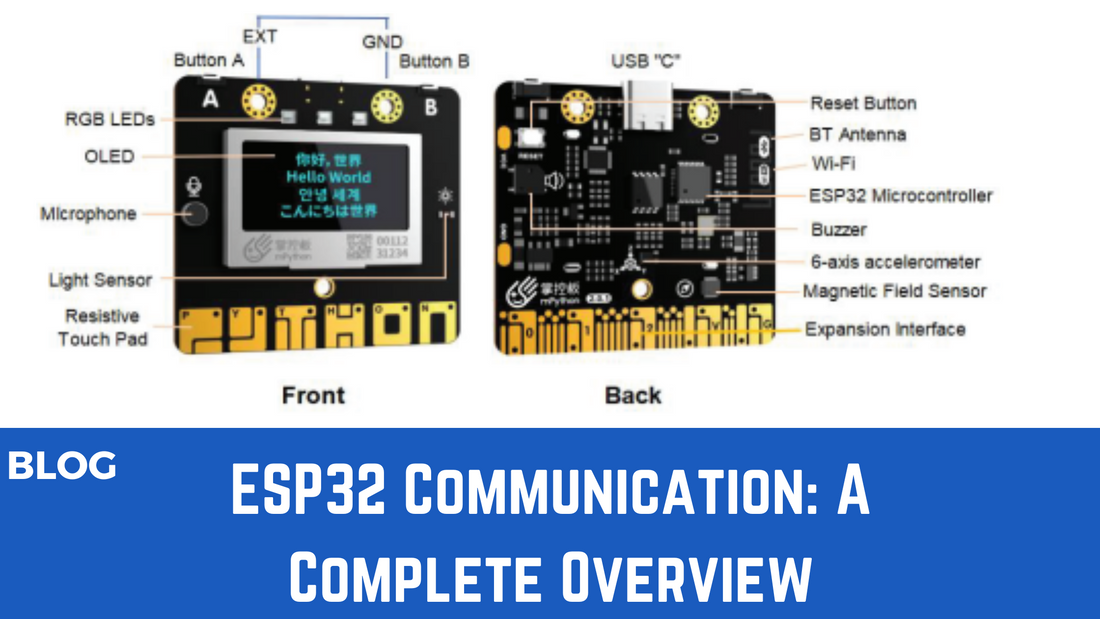
ESP32 Communication: A Complete Overview
The ESP32 microcontroller is known for its versatility and wide range of communication protocols, making it an ideal choice for IoT and smart devices. Whether you're developing smart home automation systems or need fast, low-power communication between devices, the ESP32 provides numerous communication options. In this blog, we'll explore the different types of ESP32 communication protocols, with a focus on ESP-NOW, a low-latency wireless communication protocol designed for device-to-device interaction.
By the end of this guide, you'll have a deeper understanding of how to leverage the ESP32 for efficient and scalable communication, and we'll also provide links to related resources to help you take your projects further.
Types of ESP32 Communication Protocols
The ESP32 supports a variety of communication methods, making it an extremely flexible microcontroller for different types of projects. Here’s a brief overview of the key communication options:
-
Wi-Fi: ESP32’s built-in Wi-Fi module allows for internet connectivity, enabling devices to connect to cloud services, send data over the web, or act as a server.
-
Bluetooth and BLE: The ESP32 supports both classic Bluetooth and Bluetooth Low Energy (BLE), ideal for short-range communication between devices, such as wearables or smart appliances.
-
UART, SPI, I2C: These serial communication protocols allow the ESP32 to connect with a wide range of peripherals like sensors, displays, and other microcontrollers.
-
ESP-NOW: One of the standout features of the ESP32, ESP-NOW allows fast and efficient peer-to-peer communication without the need for a Wi-Fi router or complex network setup. This protocol is perfect for low-latency communication between multiple devices, such as in remote controls, sensor networks, and IoT systems.
For a detailed guide on setting up ESP32 in IoT applications, check out our Ultimate Guide to Teaching ESP32 in K-12 Classrooms.
Device-to-Device Communication with ESP-NOW
ESP-NOW is an innovative wireless communication protocol developed by Espressif, designed for direct communication between ESP32-based devices. Unlike Wi-Fi or Bluetooth, ESP-NOW eliminates the need for a router or access point, enabling low-latency and low-power communication.
Introduction to ESP-NOW
ESP-NOW is perfect for applications where devices need to exchange data quickly and efficiently, such as remote control systems, home automation, or sensor networks.
The protocol allows devices to send up to 250 bytes of data in a single message, making it ideal for scenarios where small packets of data need to be transmitted with minimal delay.
How ESP-NOW Works
ESP-NOW operates on a peer-to-peer (P2P) protocol. Devices identify each other by their unique MAC addresses, and you can set up either one-way or two-way communication between devices.
-
One-Way Communication: In this mode, one device acts as a sender, transmitting data to another device without expecting a response. This is ideal for sensor nodes, where one device sends data, such as temperature readings, to another device for processing.
-
Two-Way Communication: Both devices exchange data with each other, allowing for more interactive applications like remote controls or IoT devices where feedback is required.
How to Set Up ESP-NOW Communication
Here’s how you can set up ESP-NOW communication between two ESP32 boards:
[insert image]
One-Way vs Two-Way Communication
For one-way communication, the sender sends data to the receiver without expecting a response. Two-way communication allows both devices to send and receive data, providing feedback.
Advantages of ESP-NOW
- Low Latency: The protocol is optimized for fast, real-time communication with minimal delays, perfect for remote control applications.
- Low Power Consumption: ESP-NOW consumes less power compared to traditional Wi-Fi or Bluetooth communication, making it ideal for battery-powered devices.
- No Wi-Fi Router Required: Since ESP-NOW is a peer-to-peer communication protocol, devices can communicate directly without relying on an internet connection or Wi-Fi network.
- Lightweight Protocol: ESP-NOW reduces communication overhead by operating on the data-link layer. This streamlined approach minimizes delays caused by network congestion.
To learn more about how ESP32 can be used for wireless communication projects, check out our post on Exploring Wireless Communication with ESP32.
Limitations of ESP-NOW
- Limited Range: The typical range of ESP-NOW is around 220 meters, which may be reduced in environments with interference or obstacles.
- Limited Data Payload: ESP-NOW can only send up to 250 bytes of data at a time, making it suitable for applications that don’t require large data transmissions.
- No Acknowledgment: ESP-NOW doesn’t provide built-in acknowledgment for message delivery, so you’ll need to implement your own error-handling mechanisms if message reliability is critical.
- Interference: ESP-NOW operates in the 2.4 GHz frequency band, which can be crowded by other devices and Wi-Fi networks. You may need to adjust the communication channel to reduce interference.
For larger data payloads or long-range communication, you may want to complement ESP-NOW with Wi-Fi or LoRa protocols.
Practical ESP-NOW Applications
- Remote Control Systems: ESP-NOW is great for building low-latency remote controls for devices like RC cars or robotic arms.
- Wireless Sensor Networks: Use ESP-NOW to create sensor networks that monitor temperature, humidity, or other environmental data without needing internet access.
- Smart Home Devices: ESP-NOW can be used to control smart lights, thermostats, or security systems within the home without relying on a Wi-Fi router.
- IoT Data Collection: Combine ESP-NOW with battery-operated sensors to collect data in areas without network coverage.
For more IoT-related ideas, check out our ESP32 and IoT Overview.
Conclusion
ESP32 communication is highly versatile, offering multiple options for both local device-to-device communication and internet-based connectivity. Among the various communication methods, ESP-NOW stands out for its low-latency, low-power, and direct communication capabilities. Whether you're building sensor networks, remote control systems, or smart home devices, ESP-NOW provides an efficient way to connect ESP32 devices without needing a central Wi-Fi network.
For more tutorials, check out our Ultimate Guide to ESP32 Projects and start building today!
